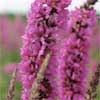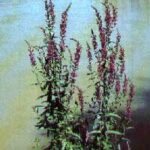HISTORY
Purple Loosestrife, Lythrun salicaria, was introduced to North America in the early 1800's as an ornamental plant.
IDENTIFICATION
Flowers: Purple to magenta in color. Long, thin spike at end of stem. Individual flowers are one to two centimeters wide with five to six petals.
Blooming Period: Late June into September
Leaves: Usually in pairs opposite each other on a four-sided (square) stem. Leaves are long, narrow and smooth-edged; attach directly to the stem. Foilage may be hairy. Sometimes leaves may alternate up the stem or grow in bunched whorls.
Roots: Perennial. Woody taproot with numerous fibrous side shoots.
Growth: Upright, semi-woody, hardy perennial with a dense bushy growth of 1 to 50 stems. The stems grow up to two meters high and may branch.
Seed: A mature plant can produce up to 2.7 milion seeds annually. Seeds are as small as grains of sand. They are easily spread by water, wind wildlife and humans. Seeds germinate the following season or can lay dormant for several years before sprouting. Plants generally start to go to seed in mid-August.
WHY A PROBLEM
Purple Loosestrife grows in wetlands and along freshwater lakes, streams, rivers and creeks. It provides little or no value to wildlife; displaces native species and chokes out wildlife habitat. It clogs drainage ditches and irrigation canals.
METHODS OF CONTROL
Purple Loosestrife is controlled using herbicide and mechanical methods. Flowertops can be clipped and the stalks dabbed with herbicide. Hand removal methods which include digging up the plant can be effective for small areas. To help control the problem, do not plant, transport, buy or sell any form of Purple Loosestrife.
Click on images for an enlarged view.
For More Information Contact:
Land and Water Resources Dept.
P.O. Box 460
Balsam Lake, WI 54810
Phone: 715-485-8699
Fax: 715-485-8601


